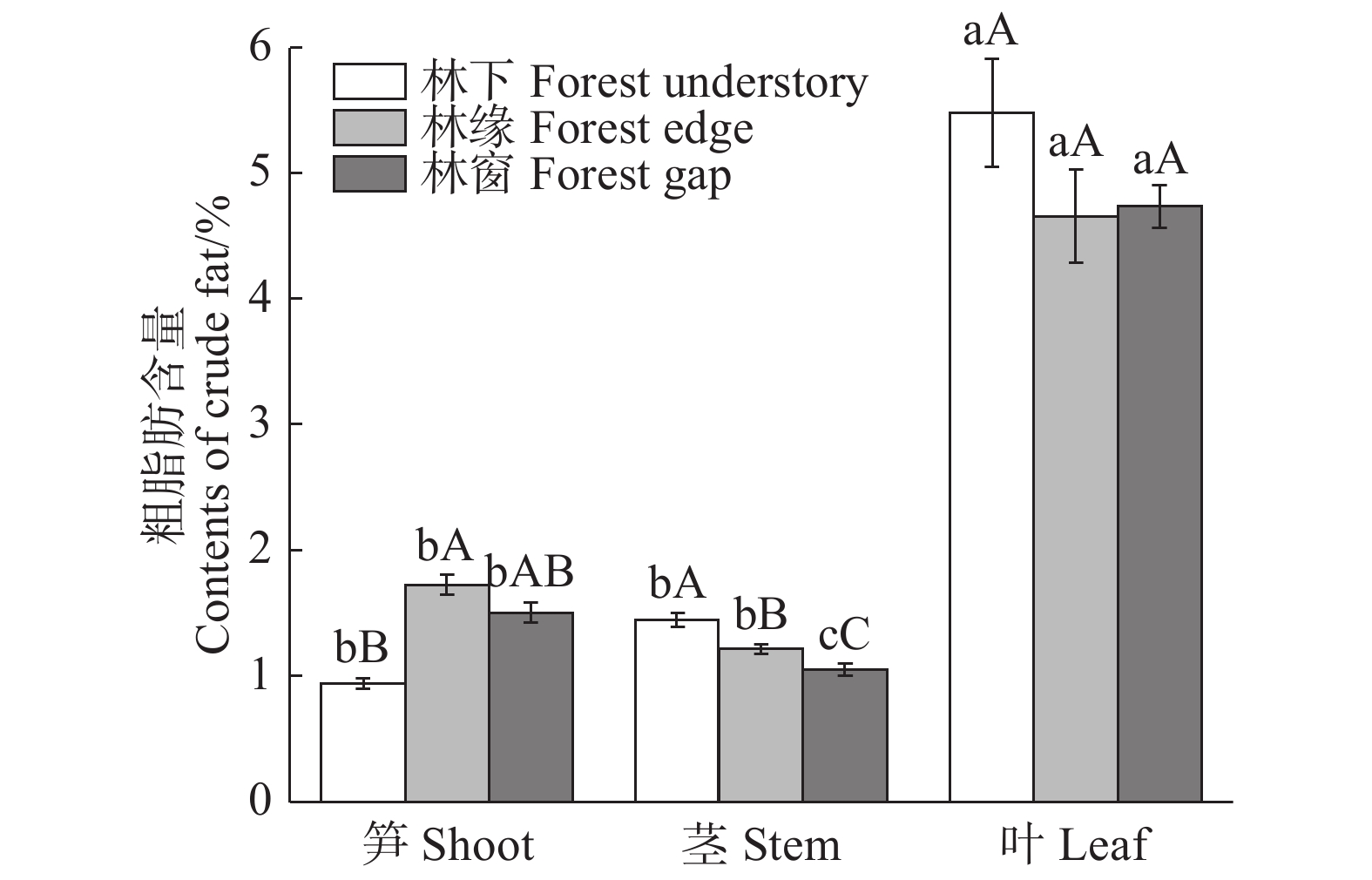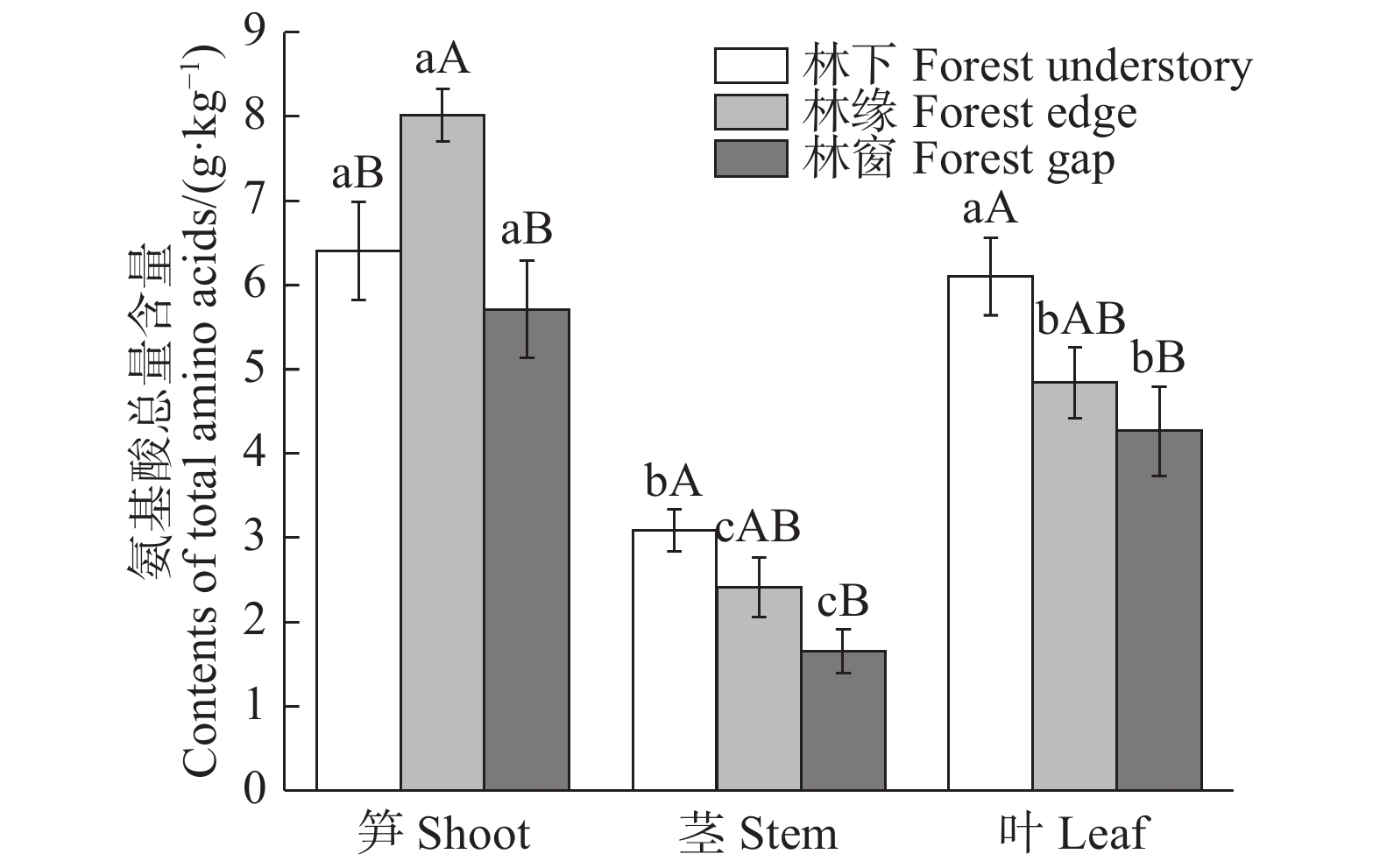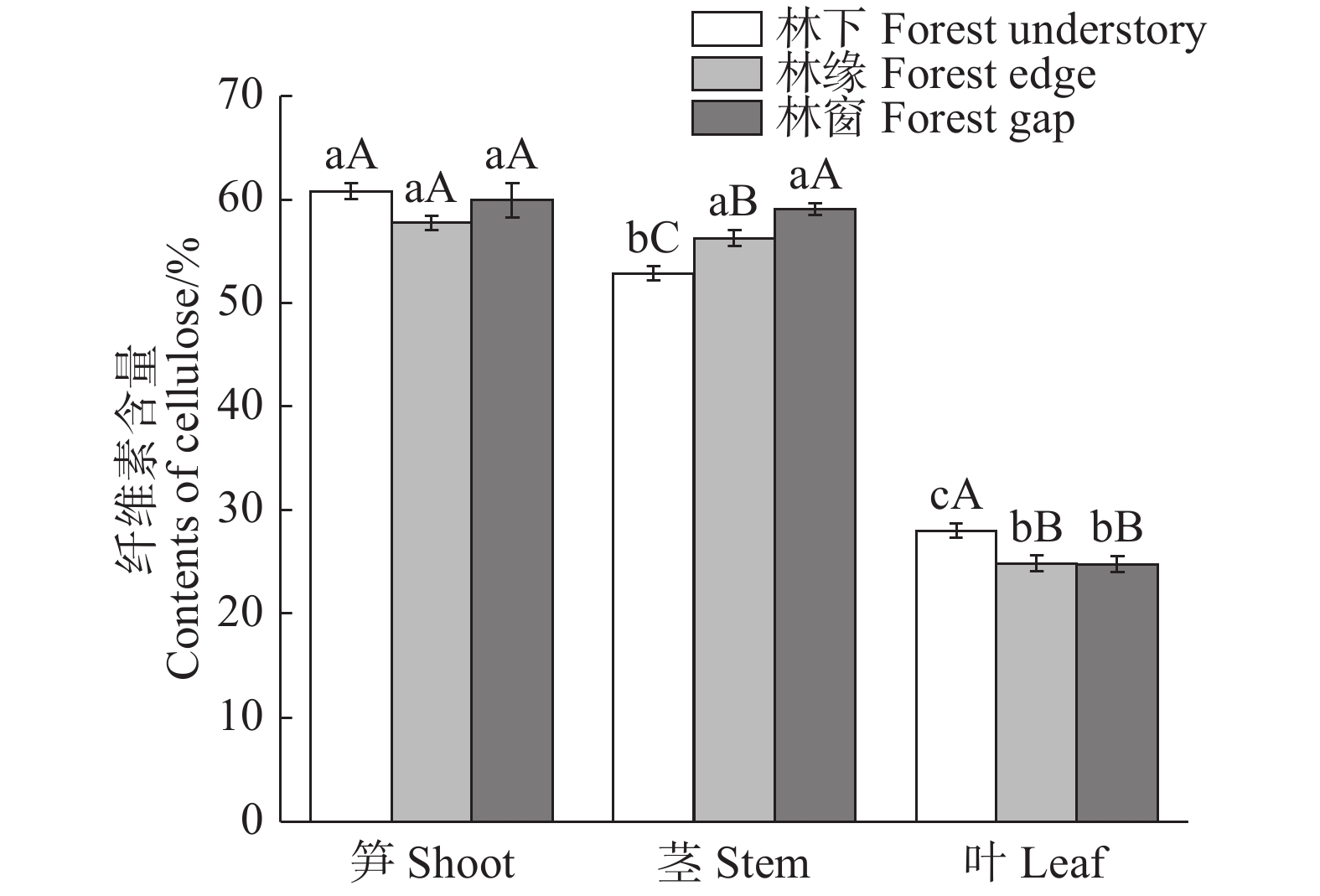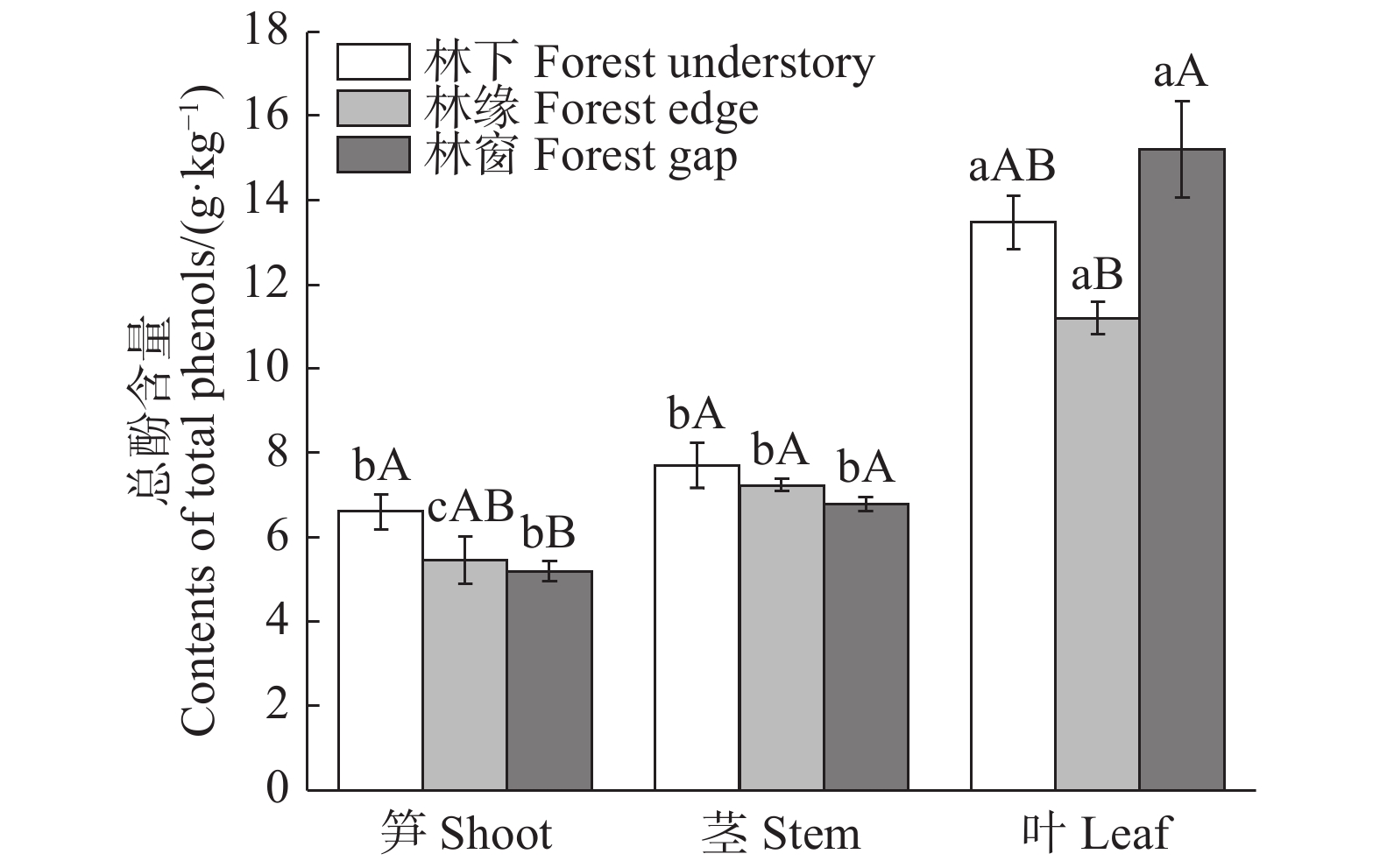-
野生大熊猫(Ailuropoda melanoleuca)的食性十分狭窄,几乎只吃竹子[1, 2],关于大熊猫取食竹种的可食性一直是其保护和研究的重点内容之一。大熊猫取食竹种的可食性包括营养成分和单宁、总酚等次级代谢产物[3],由于单宁、总酚具有涩味、苦味[4, 5]和毒性[6],并会与膳食蛋白结合形成一种难以消化的复合体,并与消化酶结合使之失去活性[7],因此大熊猫取食竹种中单宁、总酚的含量已成为大熊猫取食竹种可食性研究的重要内容。
光照是调控植物生长发育的关键环境因子,影响着植物的生长发育、光合作用、光形态建成等[8],并会直接影响着植物营养成分的含量[9]及植物的次级代谢产物等[8]。研究显示遮阴会降低郁南假花生(Desmodium heterocarpum)中粗蛋白、纤维素的含量,而适当提高光照能提高粗蛋白和纤维素的含量[10],且光照的增加会显著提高凤眼莲(Eichhornia crassipes)中蛋白质的含量[11],糯玉米籽粒中的粗蛋白和氨基酸含量随着光强的减弱而增加,但其中的粗脂肪会随着光照强度的减弱而降低[12],也有研究显示长时间光照有利于增加饲料油菜中粗蛋白、粗脂肪、粗纤维等营养物质的含量[13],并有研究显示弱光照处理条件下绿芦笋(Asparagus offinalis)合成的纤维素低于比黑暗处理条件[14]。因此,光照强度对植物中营养成分含量具有一定的影响。在单宁含量上,空地中的白屈菜(Chelidonium majus)低于遮阴环境下,且单宁含量表现为叶片>种>根>茎[15]。在森林和非洲热带雨林中,植物中的酚含量与植物受到的光照强度呈正相关[16],处于林窗环境的光叶山矾(Symplocos lancifolia)、四川山矾(S. setchuensis)、四川毛蕊茶(Camellia lawii)和细枝柃(Eurya loquaiana)个体叶片中单位质量和面积的总酚含量低于林下个体[17],而曼陀罗(Datura stramonium) 及其变种紫花曼陀罗(D. stramonium var. tatual)中的总酚含量与光照强度呈正相关[18]。因此,光照强度也会影响植物中单宁、总酚的含量。虽然当前以大熊猫取食竹种的可食性研究已层出不穷,但鲜有研究涉及不同光照强度环境下取食竹种的可食性研究,不利于取食竹种的可食性评价,有必要对其进行补充和完善。
缺苞箭竹(Fargesia denudata)是岷山山系野生大熊猫最重要的食物来源[2, 19]。在大熊猫栖息地破碎化程度不断增加且面积不断减小[20]的情况下,作为食物资源的缺苞箭竹数量和质量是大熊猫觅食行为和栖息地利用的主要驱动力[21],也是岷山山系野生大熊猫保护时需重点关注的一环。但目前对不同光照强度下缺苞箭竹可食性的研究仍然不足,不利于从光照强度影响下的可食性角度认识缺苞箭竹的质量,因此以缺苞箭竹为研究对象,比较天然林下、林缘和林窗内3种不同自然光照强度环境下的缺苞箭竹笋、茎、叶的营养成分和次级代谢产物含量,明确不同光照强度环境下的可食性成分差异,以期对此方面的内容进行补充和完善,为大熊猫取食竹种的可食性评价提供科学依据。
HTML
-
四川王朗国家级自然保护区(103°55′—104°10′E, 32°49′—33°02′N)属于岷山山系,位于四川省平武县境内,海拔为2300~4980 m,总面积约325 km2。研究区地处青藏高原和四川盆地过渡地带,属半湿润气候,11月至4月为干季,5月到10月为湿季,年均温2.5~2.9 ℃,7月平均气温12.7 ℃,1月平均气温–6.1 ℃。年降水量859.9 mm,集中于5—8月。区内植物垂直带谱明显,海拔2 300~2 600 m为针阔混交林或落叶阔叶林,2 600~3 500 m为紫果云杉-方枝柏林和岷江冷杉林,3 500~4 400 m为亚高山灌丛草甸,4 400~4 900 m为高山流石滩植被,4 900 m以上为高山荒漠带。
-
2018年9月,在四川王朗国家级自然保护区内海拔约2 800 m区域处选择坡度、坡向、土壤类型等基本一致的区域作为样地设置区,将林下(全光照的10%~15%)、林缘(全光照的20%~25%)和天然林窗(全光照的40%~45%)划分为低光照、中光照和高光照。在不同光照强度下各设置2个100 m2的样地(见表1),样地间距不小于50 m。在每个样地随机设置3个1 m×1 m的样方,样方内的竹笋和1年生克隆分株沿地表剪取,取笋、茎、叶鲜样各1 kg作为样品,并将样品于105 ℃烘箱中杀青30 min后于70 ℃烘至恒重,然后研磨、过筛、装袋保存,后期测定其笋、茎和叶中的粗蛋白、粗脂肪、氨基酸总量、纤维素、单宁和总酚含量。
样地编号 海拔 坡度/° 坡向 样地环境 优势种 光照强度 1 2810 18 西南 林下 岷江冷杉 低光照 2 2805 20 西南 林下 岷江冷杉 低光照 3 2790 19 西南 林缘 岷江冷杉 中光照 4 2800 20 西南 林缘 岷江冷杉 中光照 5 2795 22 西南 林窗 岷江冷杉 高光照 6 2810 19 西南 林窗 岷江冷杉 高光照 Table 1. Basic information of the sample plots
-
粗蛋白采用凯氏定氮法[22],粗脂肪采用乙醚浸提法[22],氨基酸总量采用茚三酮比色法[23],纤维素采用应用凡氏法(Van Soest)[24],单宁采用柠檬酸铁铵法[25],总酚采用福林试剂法[26]。
-
本文运用IBM SPSS Statistics 22软件分析数据,分别对不同光照强度环境下的缺苞箭竹笋、茎、叶可食性测定指标作单因素方差分析(One-way ANOVA),处理间的差异采用Tukey检验。所有数据均用平均值±标准误表示,显著性水平为0.05。使用Origin 8.0 软件绘制统计图。
1.1. 研究区域概况
1.2. 样品采集与保存
1.3. 测定方法
1.4. 数据处理与统计分析
-
在同一光照强度下,缺苞箭竹的笋、茎、叶中粗蛋白含量差异显著(P < 0.05),表现为叶>茎>笋,但生长于林下环境的缺苞箭竹笋和茎的粗蛋白含量无显著差异(P > 0.05, 见图1)。在笋中,粗蛋白含量表现为林窗>林缘>林下,且仅林窗和林下存在显著性含量差异(P < 0.05);在茎中,粗蛋白含量表现为林下>林缘>林窗,且林下的含量显著高于林缘和林窗(P < 0.05),而林缘和林窗并无显著性含量差异(P > 0.05);在叶中,粗蛋白含量表现为林窗>林缘>林下,且林窗的含量显著高于林下和林缘(P < 0.05),而林下和林缘并无显著性含量差异(P > 0.05)。缺苞箭竹叶具有最高的粗蛋白含量,而茎中含量最低;且其生长于林窗环境的笋和叶、林下环境的茎中粗蛋白含量较高,而林下环境的笋和叶、林缘环境的茎和叶、林窗环境的茎中粗蛋白含量较低。
-
在同一光照强度下,缺苞箭竹的叶中粗脂肪含量显著高于笋、茎的含量(P < 0.05),且仅生长于林窗环境下的缺苞箭竹笋中粗脂肪含量显著高于茎(P < 0.05, 见图2)。在笋中,粗脂肪含量表现为林缘>林窗>林下,且仅林下和林缘的含量存在显著性差异(P < 0.05);在茎中,粗脂肪含量表现为林下>林缘>林窗,且存在显著性含量差异(P < 0.05);在叶中,粗脂肪含量表现为林下>林窗>林缘,但无显著性含量差异(P > 0.05)。说明缺苞箭竹的叶中具有最高的粗脂肪含量;且其生长于林缘环境的笋、林下环境的茎中粗脂肪含量较高,而林下环境的笋、林窗环境的茎中粗脂肪含量较低。
-
在同一光照强度下,缺苞箭竹的氨基酸总量含量表现为笋>叶>茎,且笋、茎、叶三者在林缘和林窗中的含量存在显著性差异(P < 0.05),而林下环境笋和叶的含量显著高于茎(P < 0.05, 见图3)。在笋中,氨基酸总量含量表现为林缘>林下>林窗,且林缘的含量显著高于林下和林窗(P < 0.05);在茎和叶中,氨基酸总量含量均表现为林下>林缘>林窗,且林下与林窗存在显著性含量差异(P < 0.05)。说明缺苞箭竹的笋中氨基酸总量含量最高,茎中含量最低;且其生长于林缘的笋、林下环境的茎和叶中氨基酸总量含量较高,而林下环境的笋以及林窗的笋、茎和叶中氨基酸总量含量较低。
-
在同一光照强度下,缺苞箭竹的纤维素含量表现为笋>茎>叶,且林下环境的笋、茎、叶存在显著性含量差异(P < 0.05),林缘和林窗环境的笋、茎中纤维素含量显著高于叶的含量(P < 0.05,见图4)。在笋中,纤维素含量表现为林下>林窗>林缘,但三者间无显著性含量差异(P > 0.05);在茎中,表现为林窗>林缘>林下,且三者间存在显著性含量差异(P < 0.05);在叶中,表现为林下>林缘>林窗,且林下的含量显著高于林缘和林窗(P < 0.05)。说明缺苞箭竹的笋中纤维素含量高,叶中纤维素含量最低;且其生长于林窗环境的茎、林下环境的叶中纤维素含量较高,而林下环境的茎、林缘和林窗环境的叶中纤维素含量较低。
-
在同一光照强度下,缺苞箭竹的笋、茎、叶中单宁含量差异显著(P < 0.05),表现为叶>茎>笋。在笋中,单宁含量表现为林下>林缘>林窗,但三者间在含量上无显著性差异(P > 0.05, 见图5);在茎中,表现为林缘>林下>林窗,而三者间在含量上亦无显著性差异(P > 0.05);在叶中,表现为林窗>林缘>林下,且林下和林缘存在显著性含量差异(P < 0.05)。说明缺苞箭竹的叶中单宁含量最高,笋中单宁含量最低;且其生长于林窗环境的叶中具有较高的单宁含量,而林下环境的叶具有较低含量的单宁含量。
-
在同一光照强度下,缺苞箭竹的总酚含量表现为叶>茎>笋,且笋、茎、叶三者仅在林缘环境中的含量存在显著性差异(P < 0.05),在林下和林窗环境下叶的总酚含量显著高于笋、茎的含量(P < 0.05, 见图6)。在笋中,总酚含量表现为林下>林缘>林窗,且仅林下与林窗有显著性含量差异(P < 0.05);在茎中,亦表现为林下>林缘>林窗,但三者间在含量上无显著性差异(P > 0.05);在叶中,表现为林窗>林下>林缘,且仅林下与林窗有显著性含量差异(P < 0.05)。说明缺苞箭竹的叶中总酚含量最高,笋中总酚含量最低;且其生长于林下环境的笋、林窗环境的叶具有较高的总酚含量,而林窗环境的笋、林缘环境的叶具有较低的总酚含量。
2.1. 营养成分
2.1.1. 粗蛋白
2.1.2. 粗脂肪
2.1.3. 氨基酸总量
2.1.4. 纤维素
2.2. 单宁与总酚
2.2.1. 单宁
2.2.2. 总酚
-
研究结果表明,不同光照强度下缺苞箭竹的笋、茎、叶中可食性成分表现出复杂性和差异性,即低光照强度环境有利于缺苞箭竹笋中总酚的积累,而不利于粗蛋白、粗脂肪、氨基酸总量的积累,有利于茎中粗蛋白、粗脂肪和氨基酸总量的积累,而不利于纤维素的积累,有利于叶中氨基酸总量、纤维素的积累,而不利于粗蛋白、单宁的积累;中光照强度环境有利于笋中粗脂肪、氨基酸总量的积累,不利于茎和叶中粗蛋白的积累,也不利于叶中纤维素、总酚的积累;高光照强度环境有利于笋中粗蛋白的积累,而不利于氨基酸总量、总酚的积累,有利于茎中纤维素的积累,而不利于粗蛋白、粗脂肪、氨基酸总量的积累,有利于叶中粗蛋白、单宁、总酚的积累,而不利于氨基酸总量、纤维素的积累。
经比较发现,不同光照强度下缺苞箭竹的笋、茎、叶中可食性成分的含量与冯斌[27]在该区域海拔2 776 m的研究结果存在差异,如其林下环境的笋中粗蛋白、总脂肪含量最高,而本研究中对应光照强度环境下的笋中两成分含量较低。由于两研究的采样季节和海拔存在差异,且其设置了不同的海拔梯度,因此采样时间和海拔差异可能是引起差异的主要原因,为进一步弄清出现差异的原因,需对此做进一步的研究。
由于大熊猫摄食与粗蛋白、粗脂肪及磷含量呈正相关关系[28],与粗纤维含量呈负相关关系[28],且粗纤维由纤维素和木质素组成[29],故大熊猫喜欢摄食纤维素低的取食竹种部位。氨基酸作为营养成分的标志,其含量越高越受动物喜爱[30],大熊猫喜食单宁含量低的部位[31, 32],且单宁是植物多酚[5],故大熊猫喜食单宁、总酚含量低的竹种部位。而在本研究中,不同光照强度环境下的缺苞箭竹的笋均具有高含量的氨基酸总量、纤维素和较低含量的单宁、总酚,茎均具有较低含量的粗蛋白、氨基酸总量,叶均具有高含量的粗蛋白、粗脂肪、单宁、总酚和较低含量的纤维素,上述这种缺苞箭竹笋、茎、叶具有的可食性特点可能是大熊猫喜食笋、叶的主要原因。
缺苞箭竹粗蛋白和粗脂肪含量均表现为叶>笋>茎,这与冯斌[27]的研究结果基本一致,但林下环境的缺苞箭竹茎中粗脂肪含量高于笋,而表现为笋>茎>叶的纤维素含量与冯斌[27]的研究结果有差异(茎>笋>叶),单宁和总酚含量表现为叶>茎>笋,其与冯斌[27]的研究结果完全一致,说明同一地区的相似研究在结果上存一定的差异。研究显示环境条件、养分相互作用等会影响着植物中的成分含量[33, 34],同一地区的相似研究的异同可能与采样时间、微环境条件、土壤养分相互作用等因素有关,为进一步弄清出现差异性的原因,需对上述方面做进一步研究。









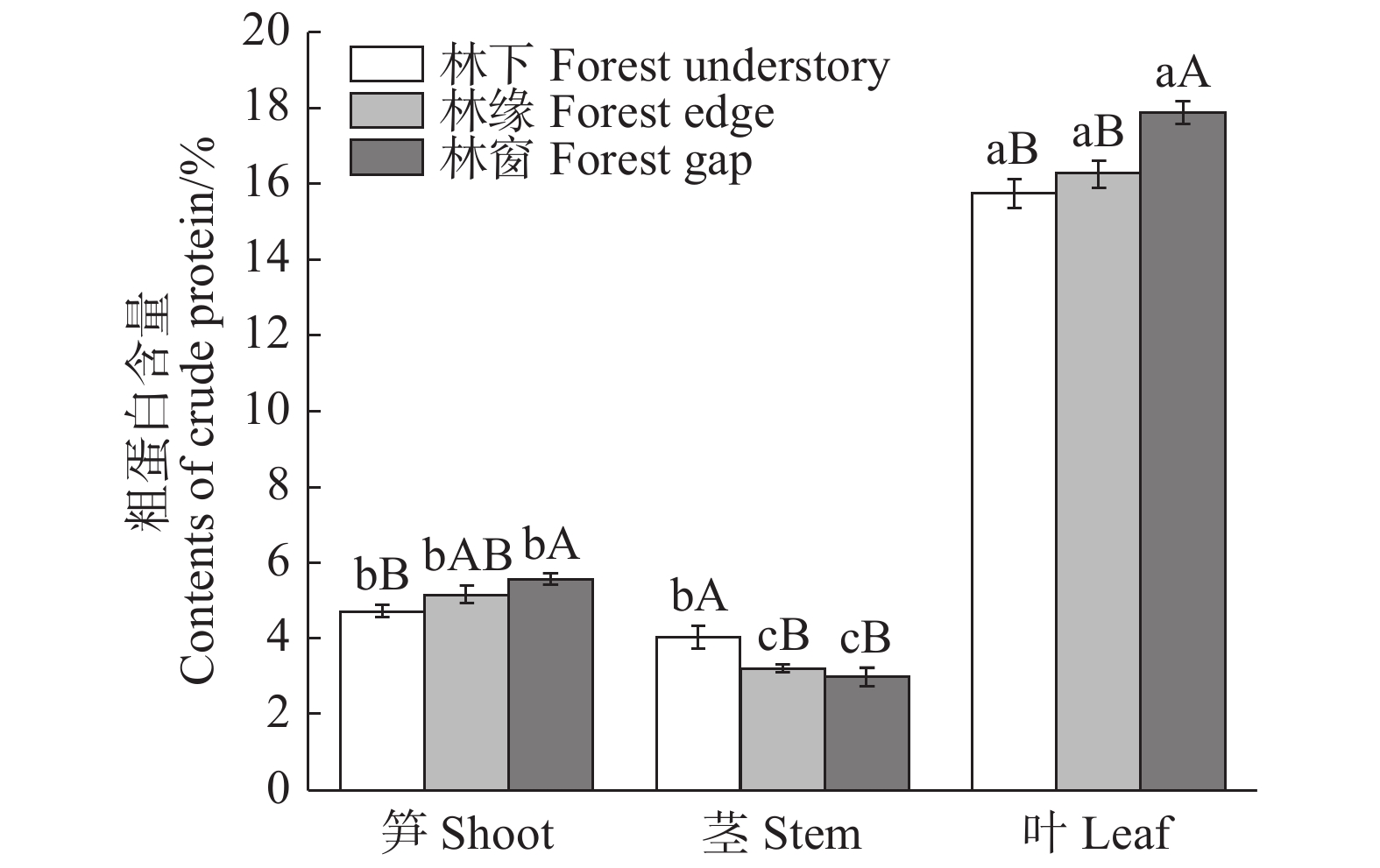


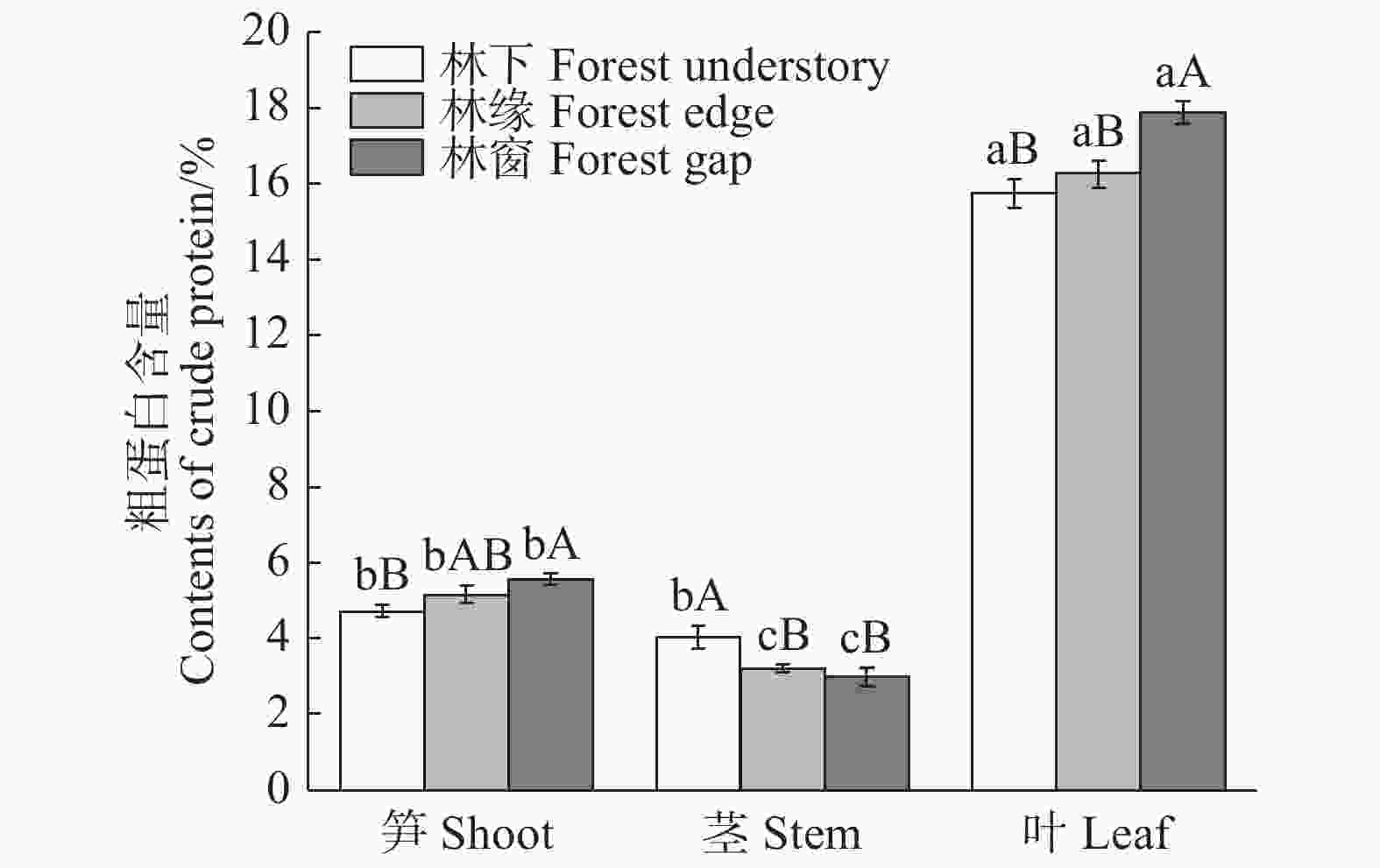
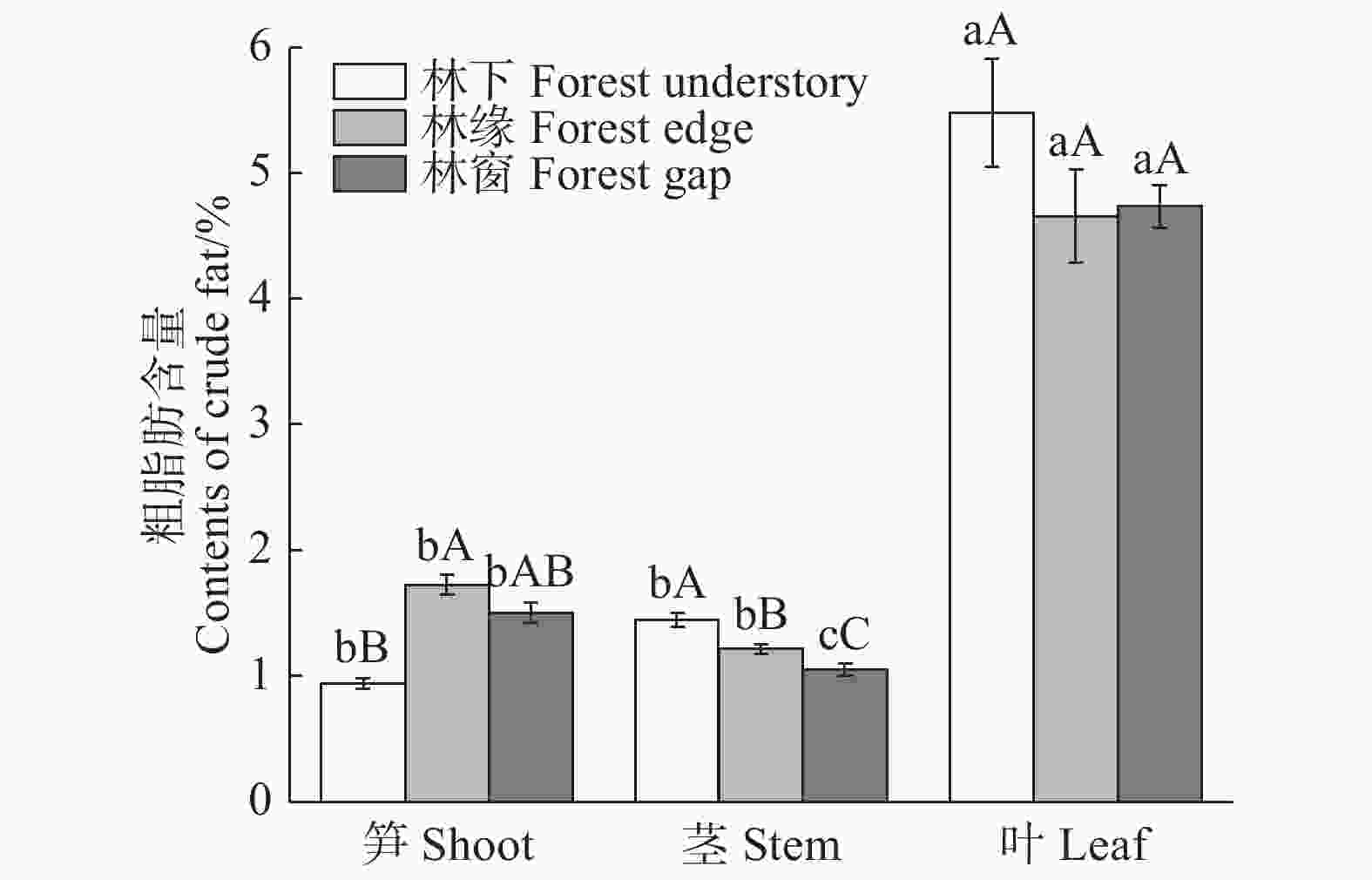
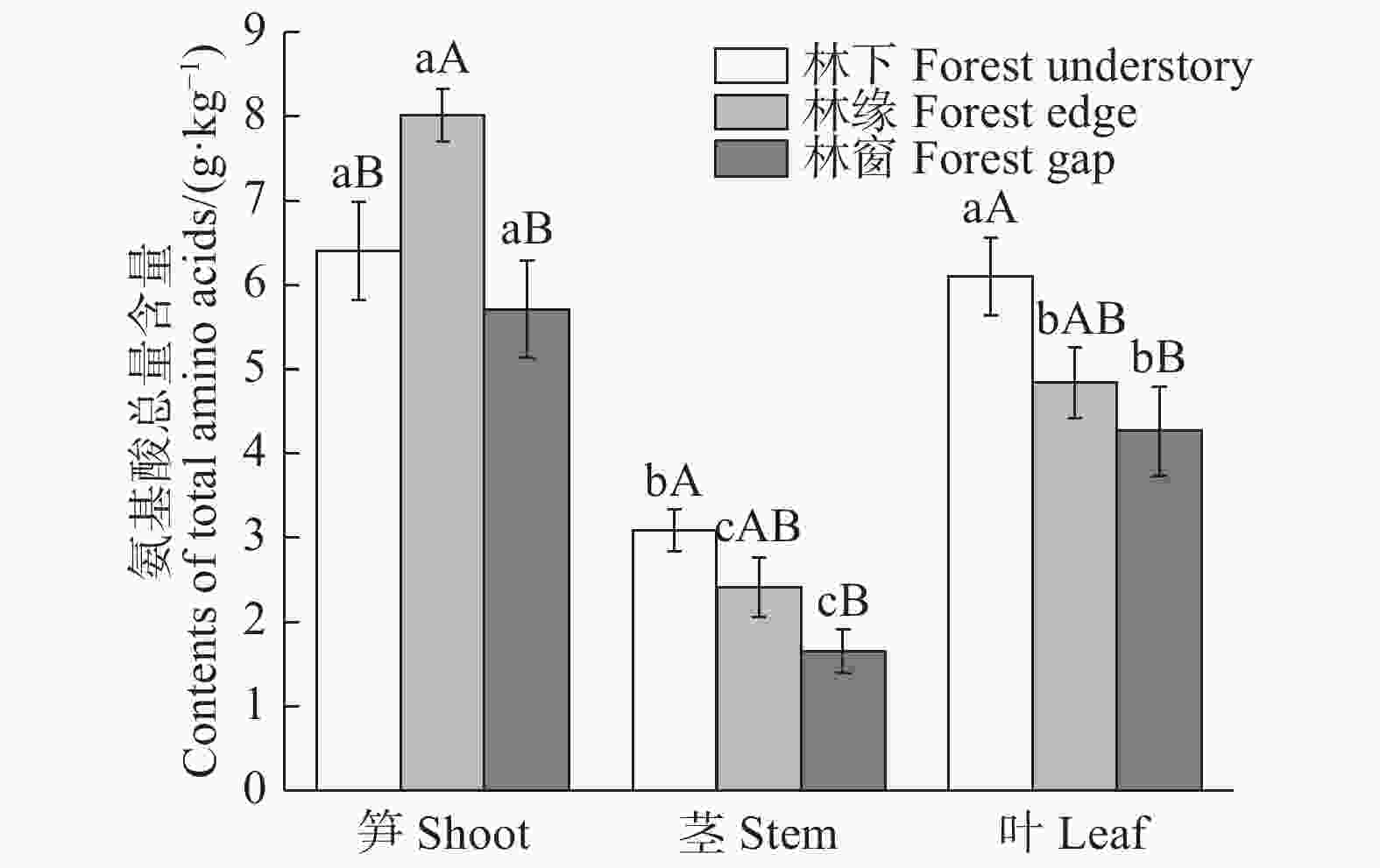
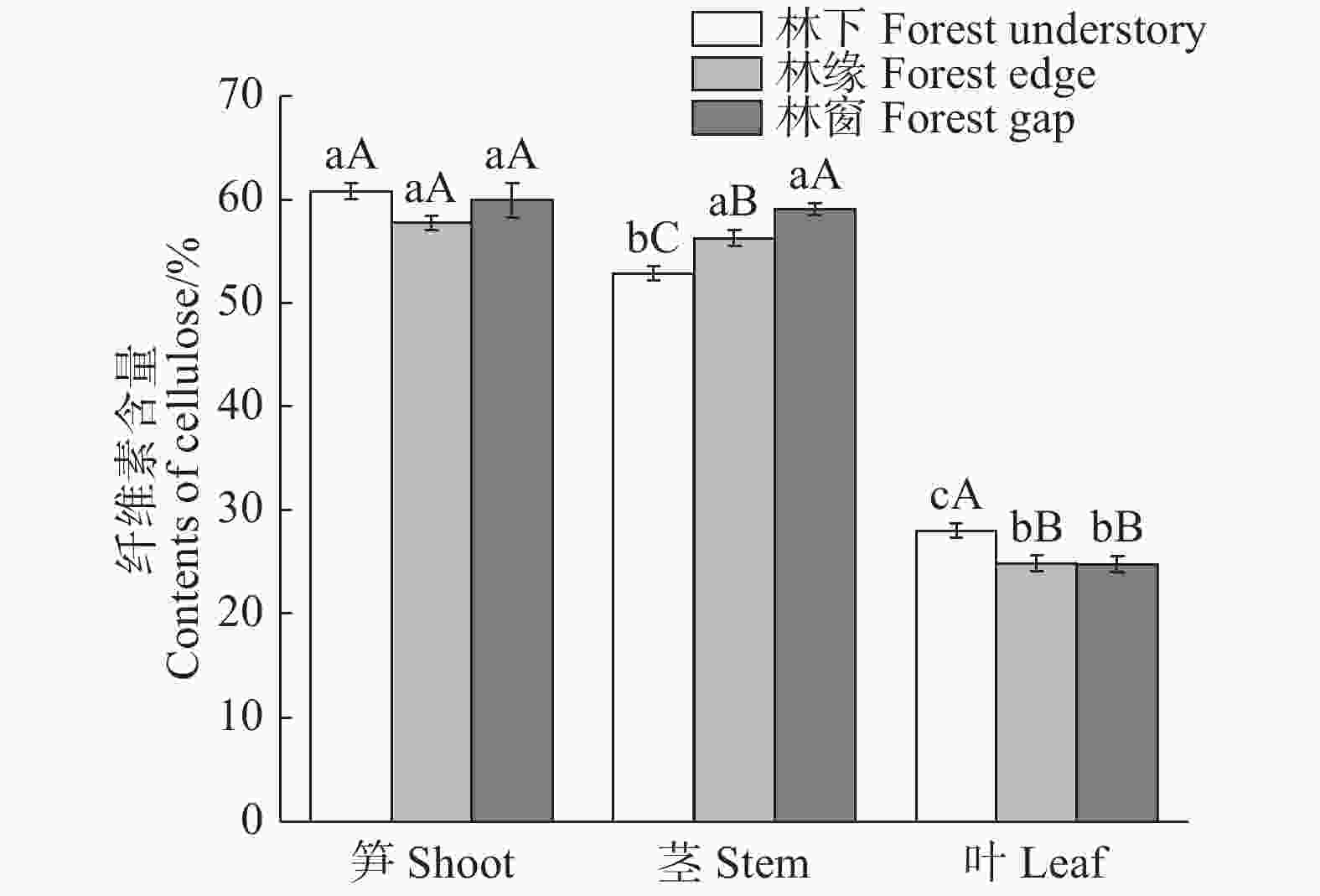
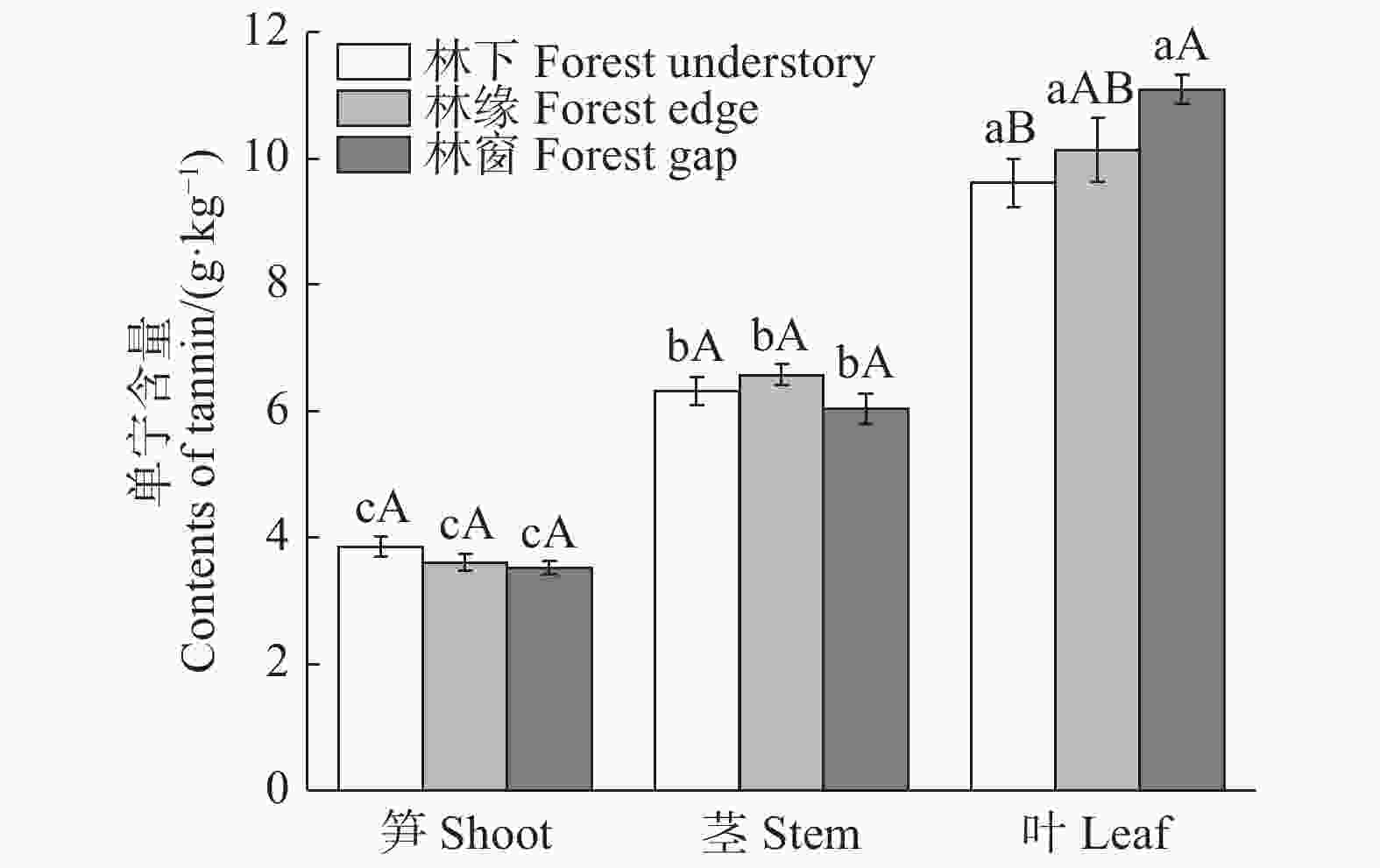

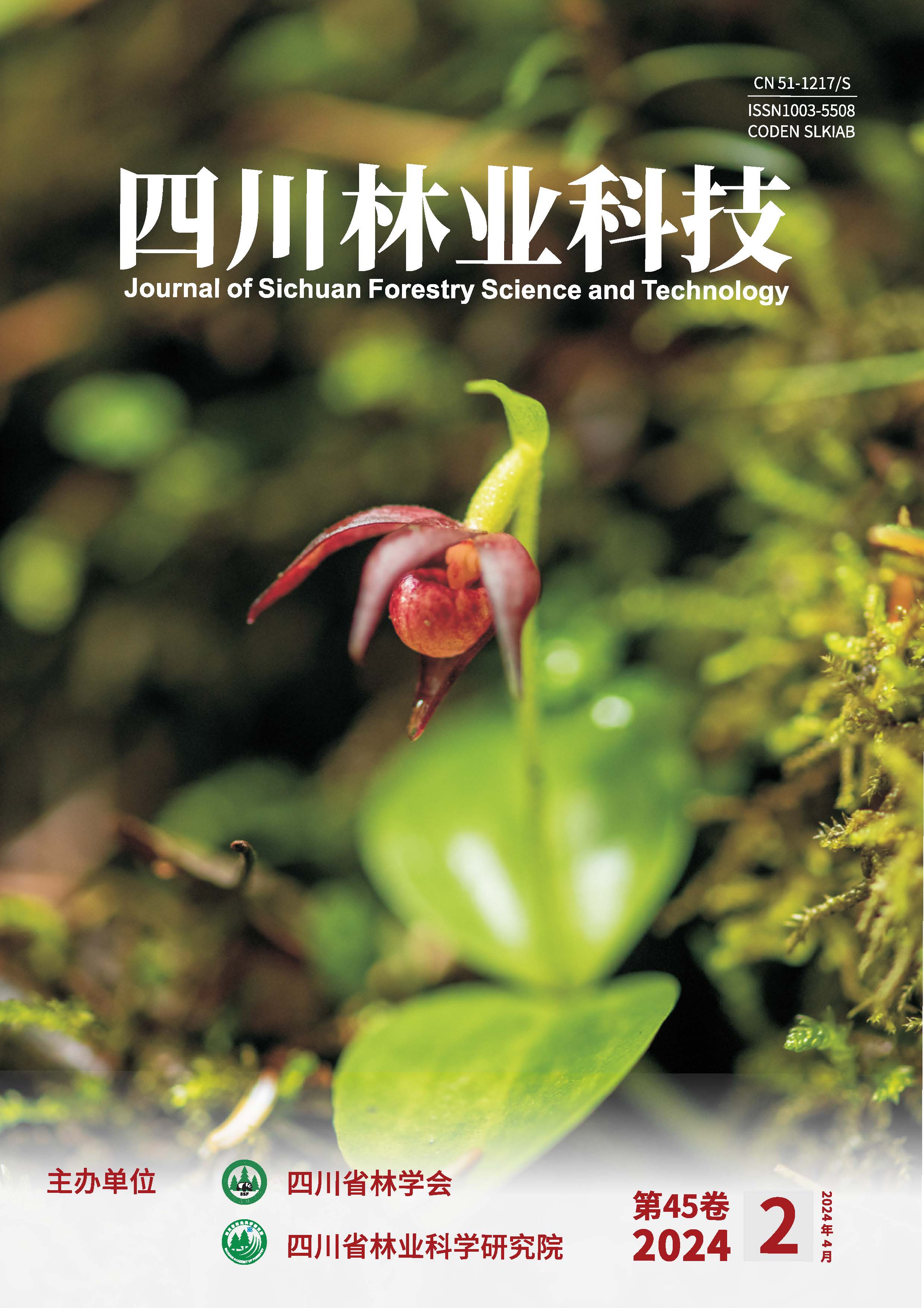
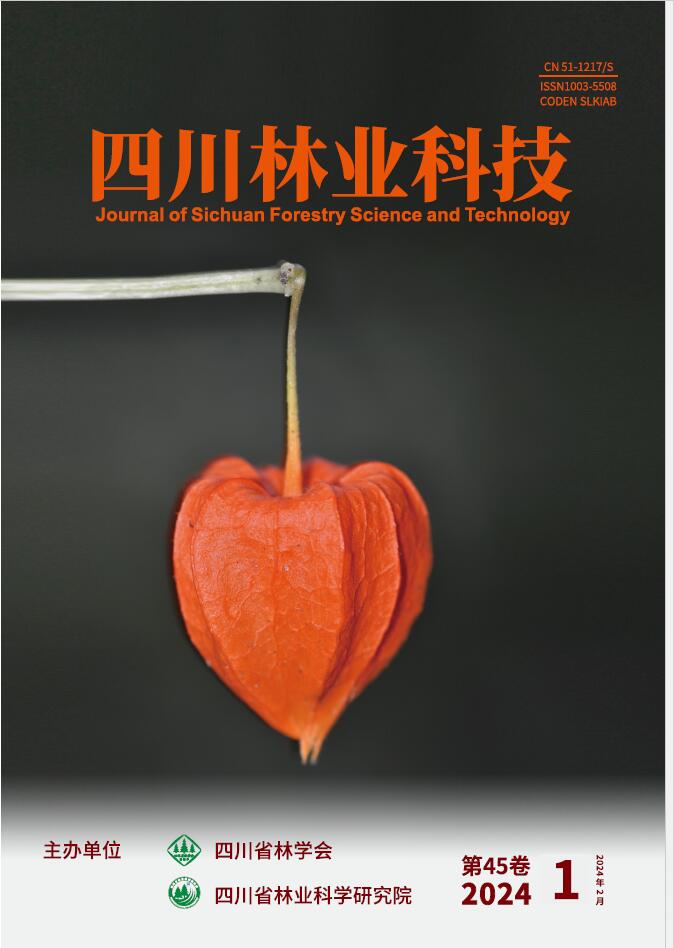
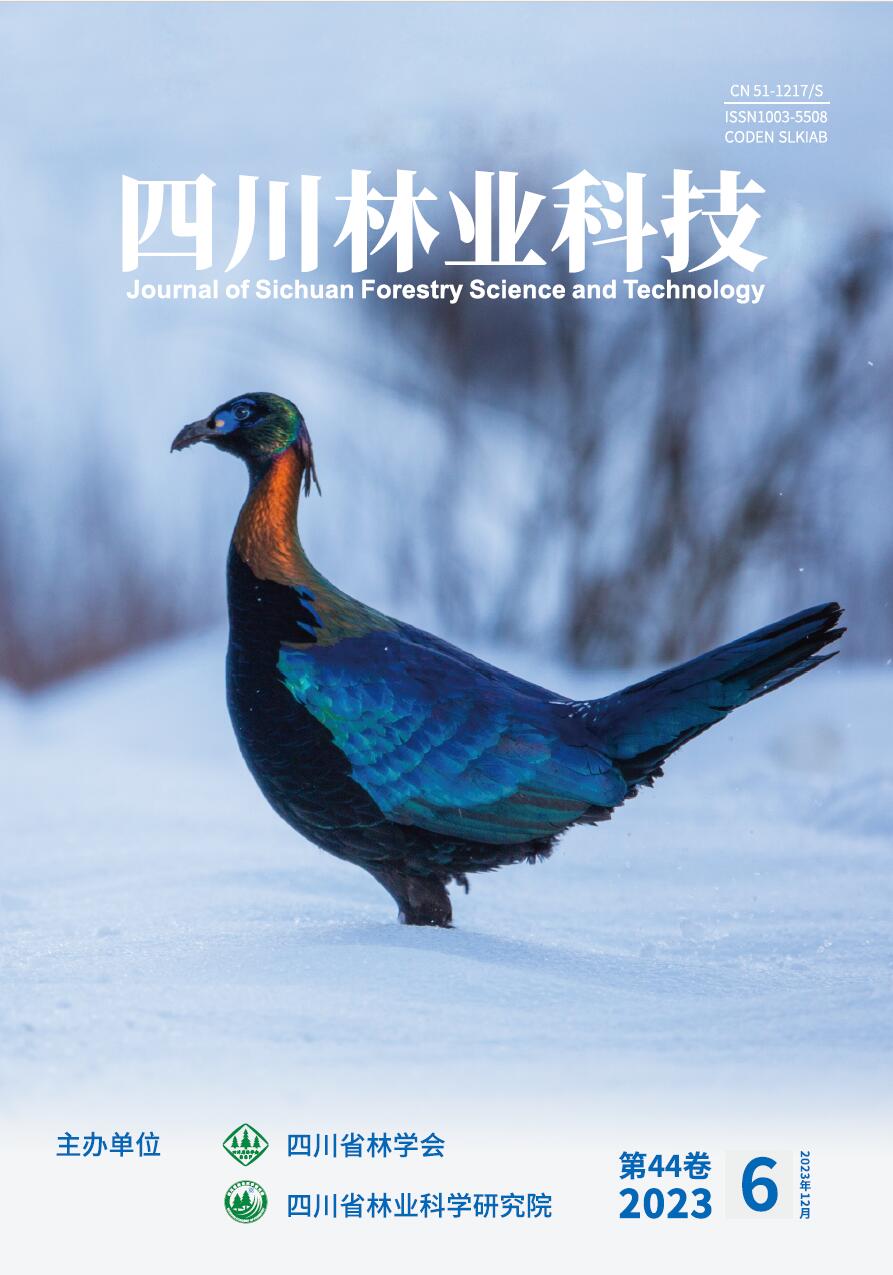
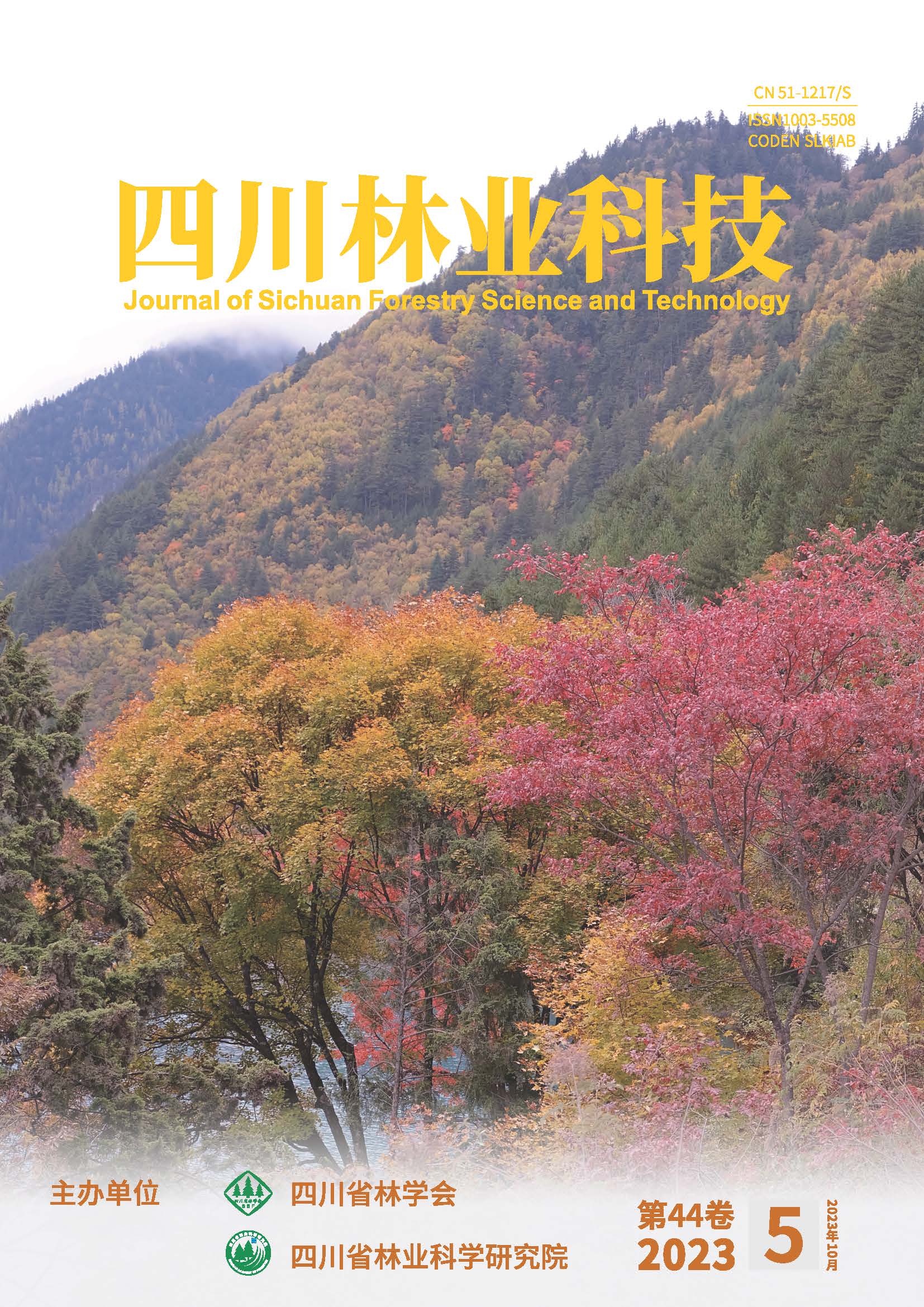
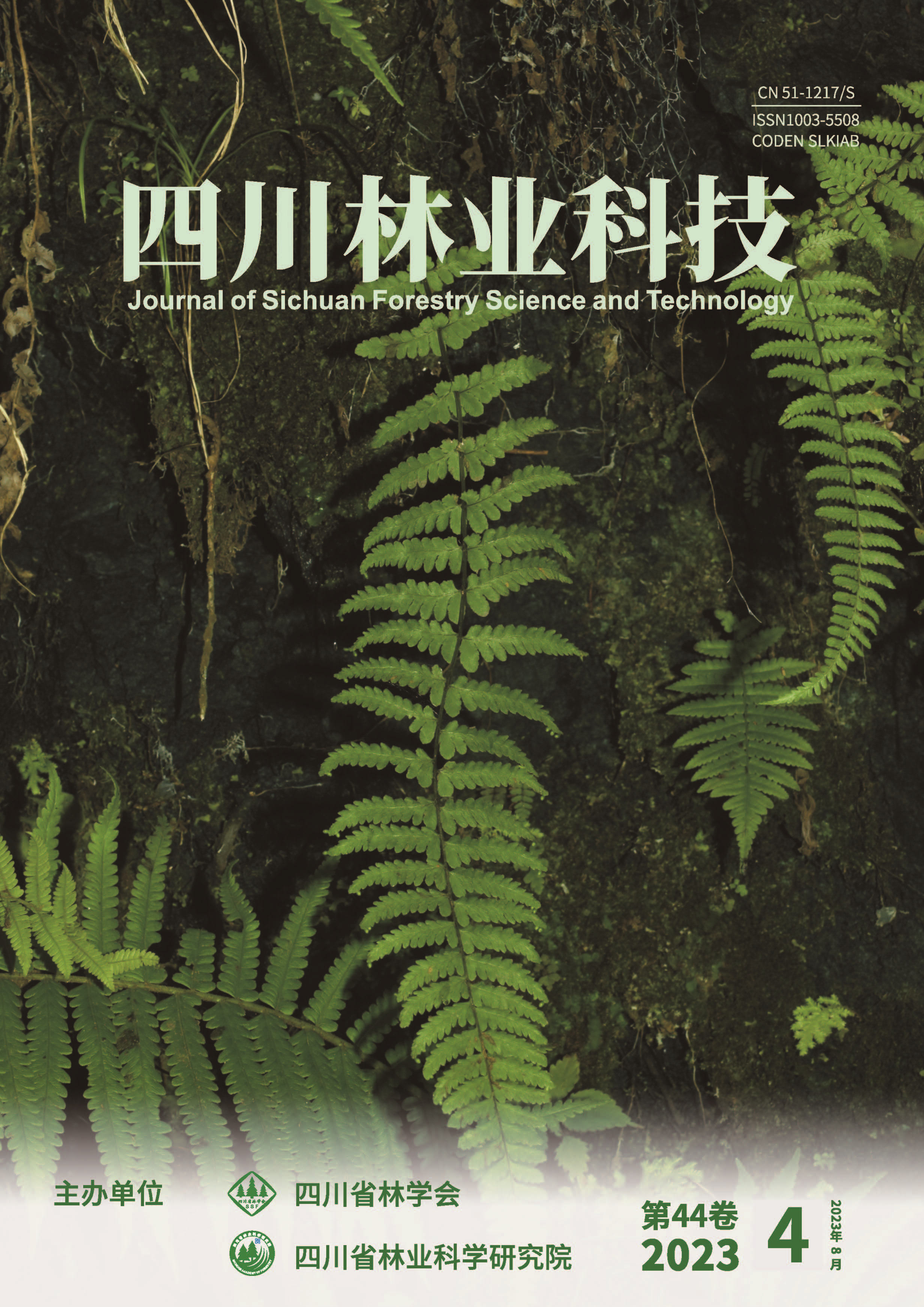
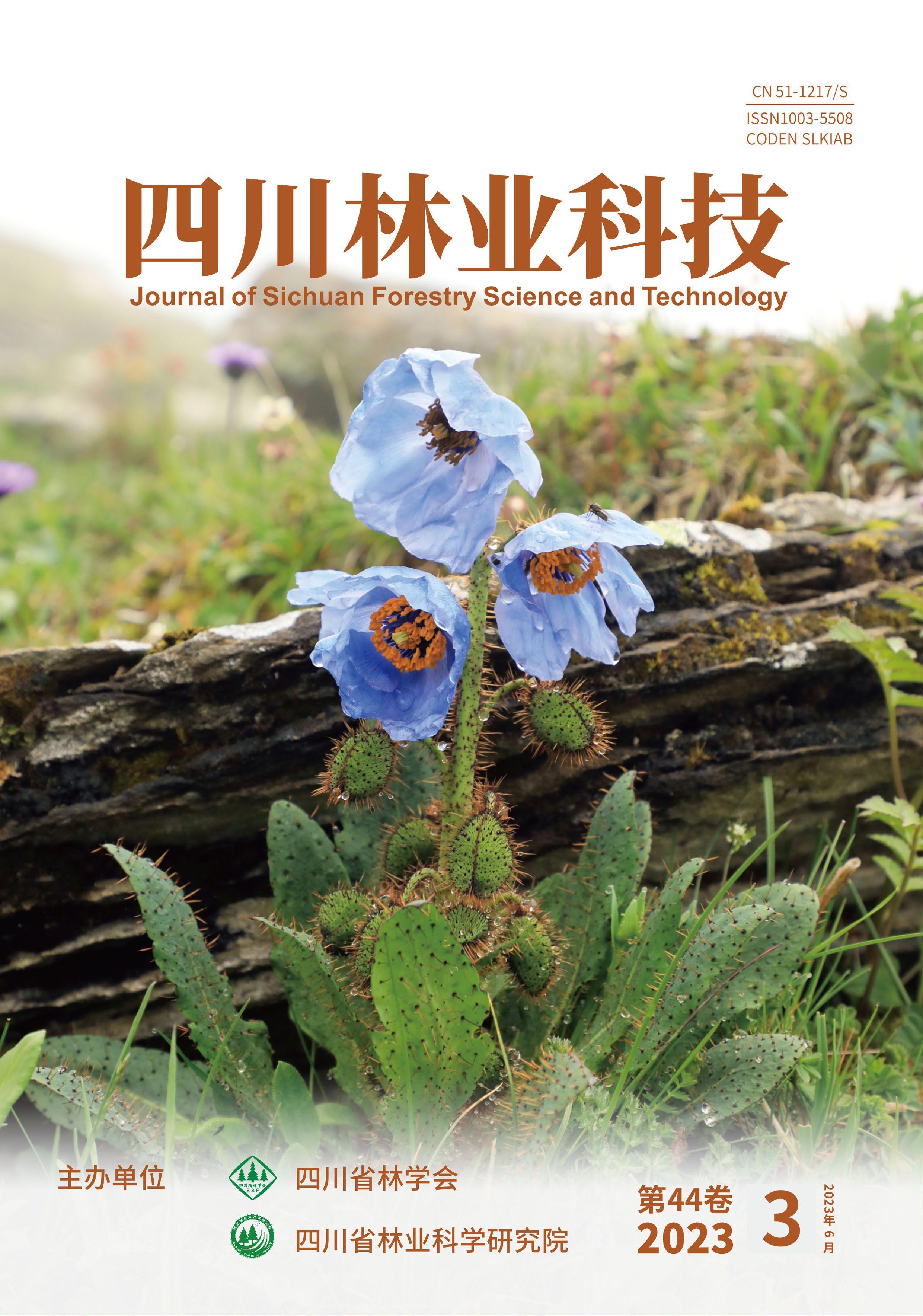
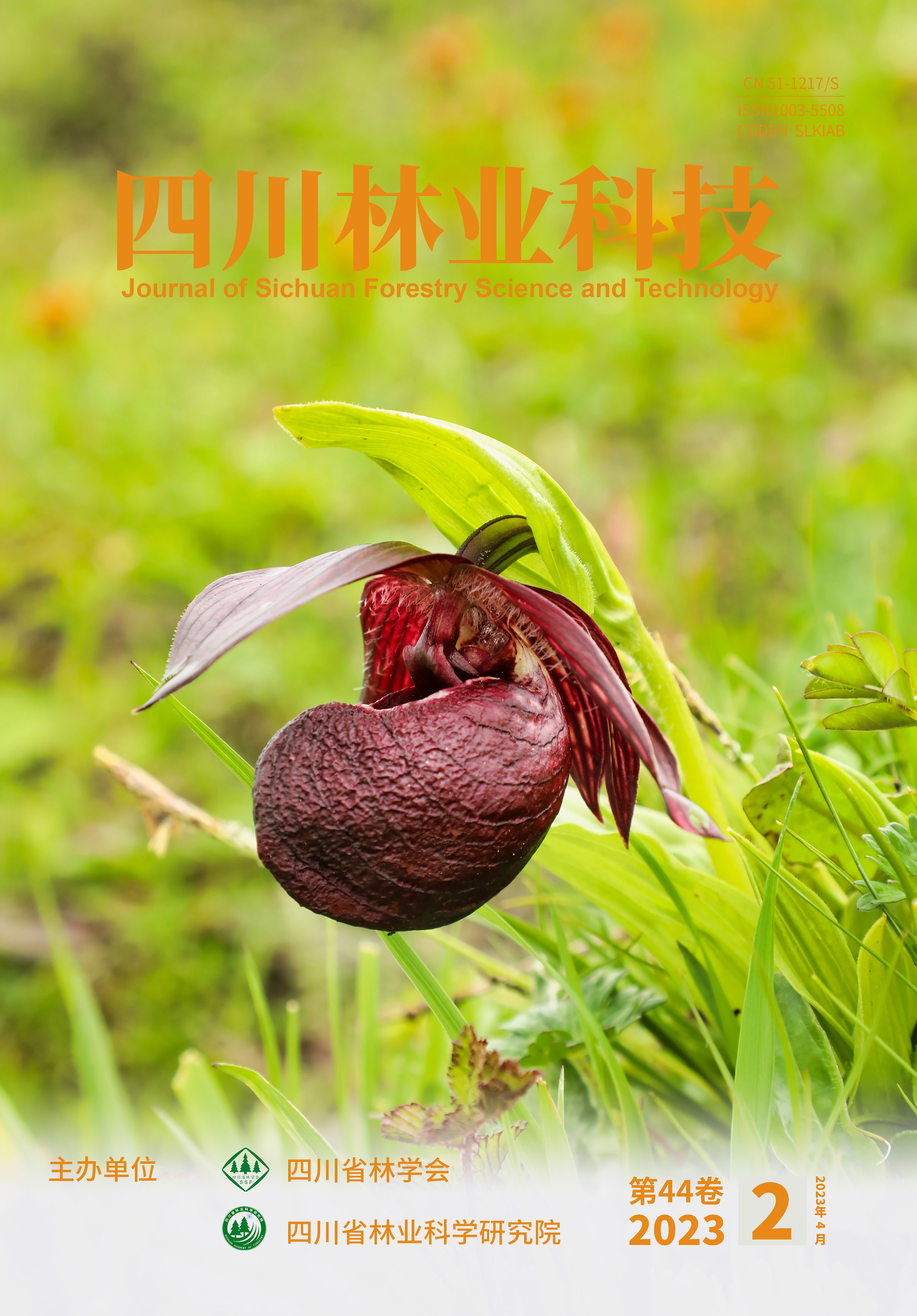
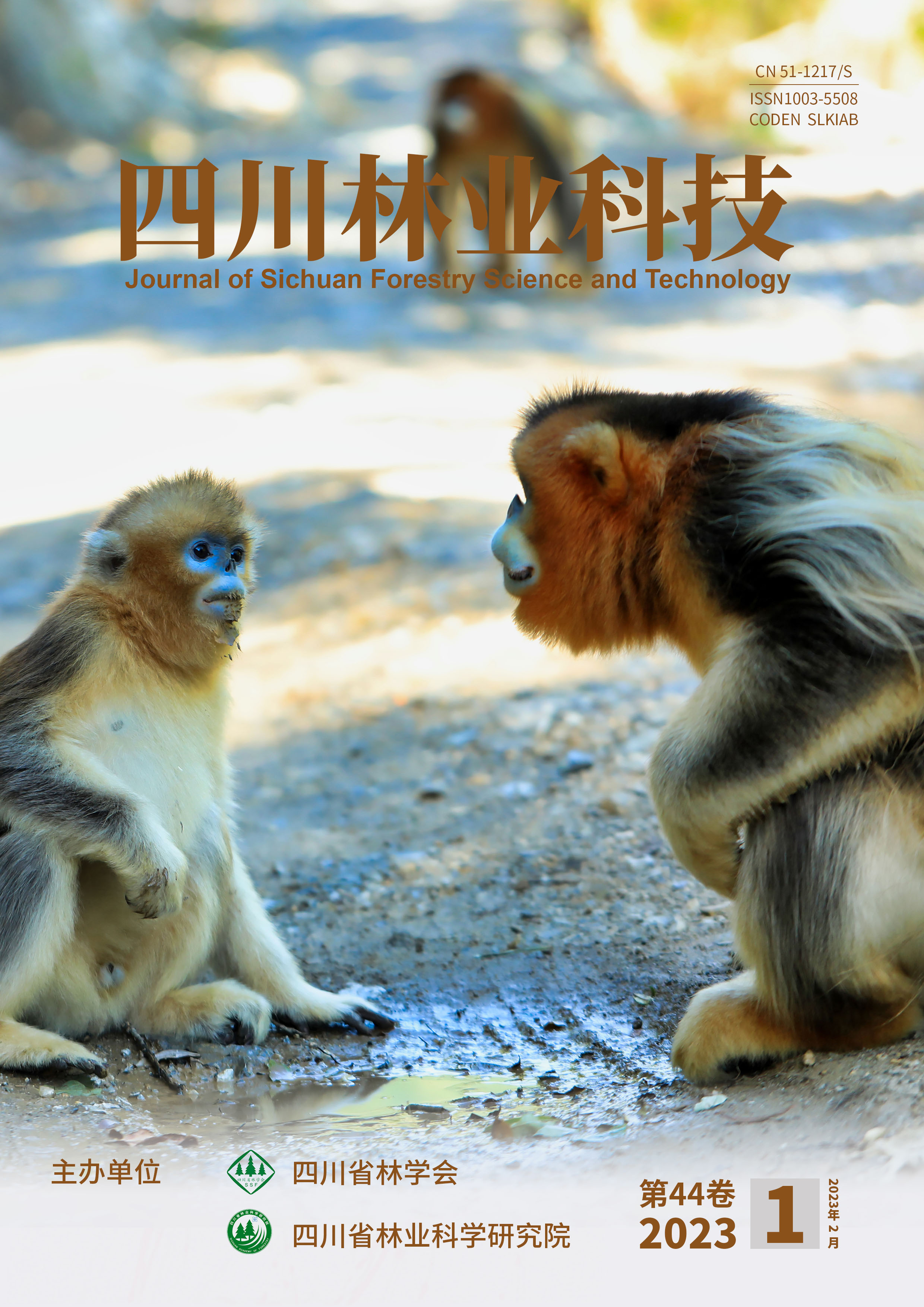


 DownLoad:
DownLoad:
